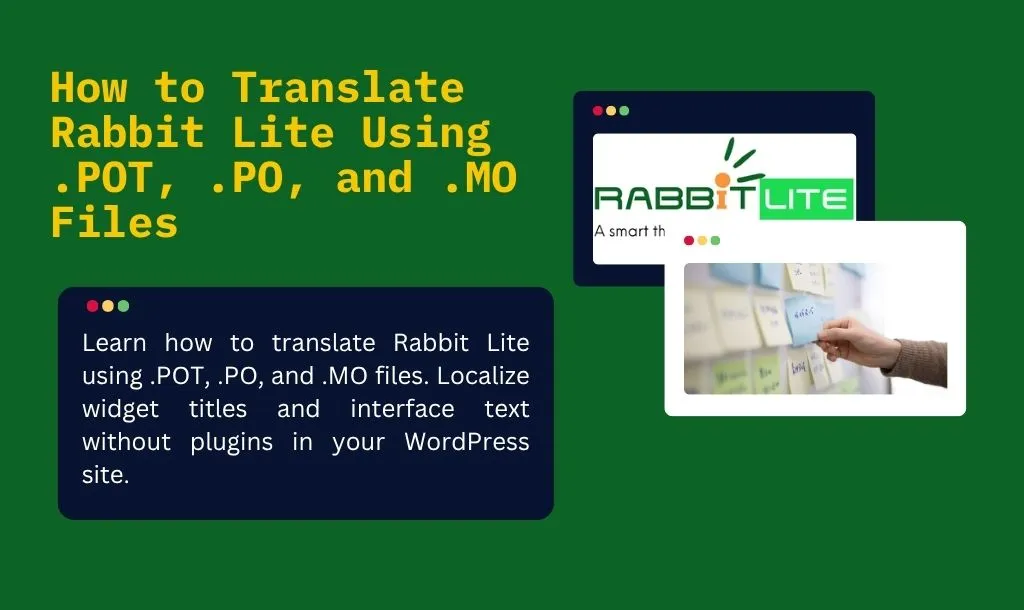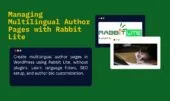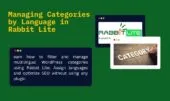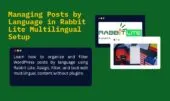- 1. Why Translate WordPress Theme Manually?
- 2. Understanding .POT, .PO, and .MO Files in Poedit WordPress Theme Translation
- 3. Locate Rabbit Lite’s .POT File for Poedit
- 4. How to Translate WordPress Theme with Poedit
- 4.1. Open rabbit-lite.pot in Poedit
- 4.2. Select Your Target Language
- 4.3. Translate All Extracted Strings
- 4.4. Save the File as rabbit-lite-xx.po
- 4.5. Let Poedit Generate the .MO File Automatically
- 4.6. Upload .PO and .MO Files to the /languages/ Folder
- 5. WordPress Widget Translation in Rabbit Lite
- 5.1. Widget Titles Are Coded for Translation
- 5.2. Widget Strings Are Included in the .POT File
- 5.3. Translations Load Automatically Based on Site Language
- 6. Where to Store Translation Files
- 6.1. Translation File Path
- 6.2. Naming Convention for Files
- 7. Switching Languages in WordPress
- 8. Troubleshooting Translate WordPress Theme Issues
- 8.1. Why are my translations not showing?
- 8.2. Can I translate dynamic content?
- 9. Conclusion
Translating a WordPress theme like Rabbit Lite is essential for delivering localized experiences. Rabbit Lite supports standard .POT, .PO, and .MO files to ensure accurate and efficient internationalization. If you’re looking to translate WordPress theme content without relying on plugins, this guide provides a complete manual approach.
Using Poedit for WordPress theme translation is the most reliable method. Rabbit Lite includes a .POT file that works seamlessly with Poedit, allowing you to create .PO and .MO files. With this workflow, you maintain control over all static text, including interface labels and layout-specific instructions.
WordPress widget translation is also supported in Rabbit Lite through this same translation system. Widget titles and other UI strings are extracted and managed via the .POT file. Once translated, they automatically adjust based on the site’s active language, ensuring a multilingual experience across all widgets without plugins.
Why Translate WordPress Theme Manually?
Manual translation offers better control and eliminates unnecessary plugin overhead. Below are the main reasons why many developers and site owners choose this method when working with Rabbit Lite:
- Avoid plugin overhead and compatibility issues: No need to install third-party translation plugins. This prevents conflicts and ensures long-term stability, especially when using lightweight themes like Rabbit Lite.
- Keep the theme lightweight and performance-optimized: Manual translation avoids loading extra scripts or features, preserving Rabbit Lite’s fast performance.
- Gain full control over translated content: You decide how each string appears in your language, including widget titles and layout labels, without relying on plugin logic.
- Ideal for developers, bloggers, and multilingual site owners: If you’re building a WordPress multilingual site without plugins, this method aligns perfectly with Rabbit Lite’s philosophy of simplicity and control.
Understanding .POT, .PO, and .MO Files in Poedit WordPress Theme Translation
Translating a WordPress theme with Poedit involves working with three file types: .POT, .PO, and .MO. These files form the backbone of a manual, plugin-free approach to multilingual site setup.
- “** (Portable Object Template)**: This file acts as the translation source. It includes all translatable strings from the theme, such as widget titles, menu labels, and interface texts. Rabbit Lite includes a default
rabbit-lite.potfile. - “** (Portable Object)**: After opening the
.POTin Poedit, you create a.POfile for your target language. This file holds the human-readable translations and can be edited anytime. - “** (Machine Object)**: This is the compiled version of the
.POfile. WordPress reads the.MOfile at runtime to display translated content. Without this file, the translated strings will not appear on the frontend.
This structure ensures that you can translate WordPress themes like Rabbit Lite, including full support for WordPress widget translation, without relying on external translation plugins. It also aligns with best practices for developers managing theme localization using Poedit.
Locate Rabbit Lite’s .POT File for Poedit
To begin translating Rabbit Lite with Poedit, you need access to the theme’s .POT file. This file contains all the translatable strings required to localize both core theme components and widget titles.
- Located in the
/languages/directory inside the Rabbit Lite theme folder - The filename is
rabbit-lite.pot, following WordPress translation conventions - Open the file using Poedit or compatible editors to start translating
- This is the standard process to prepare for a full translate WordPress theme workflow
Once opened in Poedit, you can begin creating .PO and .MO files for your desired language. This method ensures accurate WordPress widget translation and aligns with best practices for Poedit WordPress theme management.
How to Translate WordPress Theme with Poedit
Translating Rabbit Lite with Poedit involves a precise sequence that ensures all theme strings, including widget titles, are properly localized. Follow these steps to complete the process:
Open rabbit-lite.pot in Poedit
Launch Poedit and open the .POT file located in the Rabbit Lite /languages/ directory. This file includes all the translatable strings from the theme.
Select Your Target Language
Choose the language you want to translate into, such as Vietnamese, French, or German. Poedit will update the language metadata accordingly.
Translate All Extracted Strings
Translate each string one by one in Poedit’s editor. This includes widget titles, interface labels, buttons, error messages, and other user-facing texts.
Save the File as rabbit-lite-xx.po
Replace xx with the appropriate language code. For example, for Vietnamese, use rabbit-lite-vi.po. This .PO file stores your translations in an editable format.
Let Poedit Generate the .MO File Automatically
Poedit will automatically generate a corresponding .MO binary file when you save the .PO file. This .MO file is required for WordPress to apply translations.
Upload .PO and .MO Files to the /languages/ Folder
Place both files in the Rabbit Lite theme’s /languages/ directory. WordPress will load the appropriate .MO file based on the active site language.
By following this structured method, you can effectively translate WordPress themes like Rabbit Lite using Poedit—without relying on external plugins and with full support for widget title localization.
By following this method, you can fully translate WordPress theme content—including interface and widget areas—without relying on any plugin. It is also fully compatible with Poedit WordPress theme translation workflows.
WordPress Widget Translation in Rabbit Lite
Translating widget titles in WordPress themes is crucial for delivering a consistent multilingual experience. Rabbit Lite supports this by embedding translatable functions into all widget areas.
Widget Titles Are Coded for Translation
Rabbit Lite uses the standard WordPress functions __() and _e() to wrap all widget title strings. These functions mark the strings as translatable and ensure they’re captured during .POT file generation.
Widget Strings Are Included in the .POT File
All widget-related text is extracted into the Rabbit Lite .POT file. This ensures full compatibility with tools like Poedit and enables you to manage widget translations alongside other theme strings.
Translations Load Automatically Based on Site Language
After translation, WordPress will detect the active site language and load the corresponding .MO file. This allows translated widget titles to appear automatically on the frontend without requiring additional configuration or plugins.
Where to Store Translation Files
Storing your translation files in the correct location is essential for WordPress to load them properly. Rabbit Lite follows the standard theme localization structure.
Translation File Path
Place all .PO and .MO files in the following directory:
/wp-content/themes/rabbit-lite/languages/
This is the default location where WordPress looks for theme-specific translations.
Naming Convention for Files
Use language and region codes in the filenames to ensure compatibility:
- Example:
rabbit-lite-en.mofor U.S. English - Example:
rabbit-lite-fr.mofor French (France) - Example:
rabbit-lite-vi.mofor Vietnamese
Correct placement and naming allow WordPress to detect and load the correct translations based on the selected site language setting.
Switching Languages in WordPress
To apply your translations, you need to tell WordPress which language to use. This can be done directly from the WordPress admin settings without any code changes or plugins.
- Go to Settings > General in your WordPress admin panel
- Look for the Site Language dropdown
- Choose your desired locale (e.g., Vietnamese, French, German)
- Click Save Changes to apply the new language
- WordPress will automatically load the corresponding
.MOfile from the theme’s/languages/directory
Troubleshooting Translate WordPress Theme Issues
When translation issues arise, understanding the common causes can help you resolve them quickly and effectively. Below are some typical cases:
Why are my translations not showing?
If your translated content doesn’t appear, the issue often lies in file format, naming, or cache. Check the following:
- Ensure
.MOfiles are saved correctly and generated from a valid.POfile - File names must exactly match locale codes (e.g.,
rabbit-lite-vi.mofor Vietnamese) - Clear all cache layers and refresh the frontend to reflect the changes
Can I translate dynamic content?
- Only static strings in theme files are translated via
.MO - For content, use language-specific posts or filters in Rabbit Lite
Conclusion
Translating Rabbit Lite using .POT, .PO, and .MO files gives you a clean, plugin-free multilingual setup. This approach is ideal for users who want full control and performance without complexity. It is the recommended method to translate WordPress themes like Rabbit Lite, including widget titles, using Poedit.







